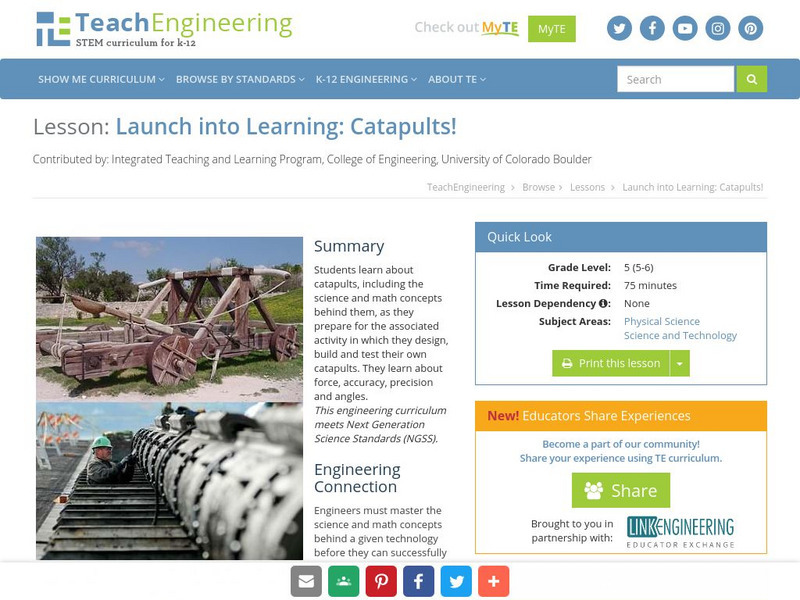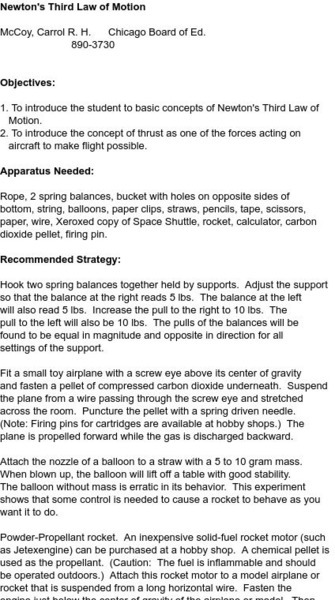Hi, what do you want to do?
Utah STEM Foundation
Utah Stem Action Center: Angry Birds Are Mad About Physics
Learn about catapults and Newton's laws of motion.
TeachEngineering
Teach Engineering: Launch Into Learning: Catapults!
Students learn about catapults, including the science and math concepts behind them, as they prepare for the associated activity in which they design, build and test their own catapults. They learn about force, accuracy, precision and...
TeachEngineering
Teach Engineering: Physics of the Flying T Shirt
Students are introduced to the physics concepts of air resistance and launch angle as they apply to catapults. This includes the basic concepts of position, velocity and acceleration and their relationships to one another. They use...
CK-12 Foundation
Ck 12: Physical Science: Force
[Free Registration/Login may be required to access all resource tools.] Definition of force, how it relates to motion, and force as a vector.
Sophia Learning
Sophia: Gravitational Force & Newton's Second Law of Motion
This lesson explains how gravitational force is related to free fall, acceleration due to gravity, and Newton's second law of motion.
Physics Classroom
The Physics Classroom: Newton's Laws: Identifying Action Reaction Force Pairs
Students are give the opportunity to practice some action-reaction pair problems. Each example is self-checking for on-the-spot reinforcement.
University of Colorado
University of Colorado: Ph Et Interactive Simulations: My Solar System
An interactive simulation that teaches about motion, acceleration, and velocity by allowing students to build their own solar system and watch the effects of gravitational pull and how that changes with initial position, velocity, and...
Science and Mathematics Initiative for Learning Enhancement (SMILE)
Smile: Third Law of Motion
This Illinois Institute of Technology site provides a teacher lesson plan for an activity in which students use spring balances and carts to investigate the action-reaction relationship for any given force. Includes directions, materials...
Science and Mathematics Initiative for Learning Enhancement (SMILE)
Smile: Third Law of Motion
This Illinois Institute of Technology site is a lesson plan and lab that utilizes a toy rocket to investigate Newton's third law. Includes directions and practical applications.
Sophia Learning
Sophia: Introduction to Tension: Lesson 1
This lesson introduces the concept of tension. It is 1 of 2 in the series titled "Introduction to Tension."
Sophia Learning
Sophia: Newton's First Law: Lesson 3
This lesson introduces Newton's First Law, that inertia causes objects at rest to remain at rest, and objects in motion to remain in motion. It is 3 of 3 in the series titled "Newton's First Law."
Sophia Learning
Sophia: Newton's Third Law: Lesson 2
This lesson will show that when a force is exerted on an object, an equal and opposite force is produced, as stated in Newton's Third Law. It is 2 of 3 in the series titled "Newton's Third Law."
Alabama Learning Exchange
Alex: Pendulums Swing Into Motion
This lesson will allow students in groups to describe the relationship between energy, work, and force through the use of pendulums. The results will be reported through a graphing activity as well as a paragraph written and printed on...
Alabama Learning Exchange
Alex: Experiencing Newton's Laws of Motion
This lesson will approach the study of Newton's 3 Laws of Motion using McGraw-Hill Science textbook Unit F. The learners will be given an overview of the laws and vocabulary words to study. After introducing and explaining the concept of...
TryEngineering
Try Engineering: Engineering Ups and Downs
Engineering design lesson examines the principles behind working elevators. Teams of students explore how elevators work, then design, build, and evaluate their own elevator to service a toy car garage.
Physics Classroom
The Physics Classroom: Newton's Laws
A four-lesson e-textbook covering topics in Newton's Laws. Tutorials include informational text,animations, interactive activities, and quick, interactive comprehension checks throughout the lessons.
TeachEngineering
Teach Engineering: Flying With Style
As students begin to understand the physics behind thrust, drag, and gravity and how these relate these to Newton's three laws of motion, groups assemble and launch the rockets that they designed in the associated lesson.
TryEngineering
Try Engineering: Can You Canoe?
Teams of students learn about the engineering design process as they design, build, and test a model canoe made with everyday materials. Lesson focuses on how materials engineering has impacted the manufacturing of canoes over time.
TryEngineering
Try Engineering: Working With Watermills
Teams of students design, build, test, and evaluate a working watermill made from everyday materials. Lesson explores how watermills generate energy from water, while students gain an understanding of the structural engineering design...
TryEngineering
Try Engineering: Water Rocket Launch
The main focus of this lesson is learning about aerospace engineering and the principles of rocketry. To accomplish this, learners will work in teams to design, build, and launch a rocket made out of a soda bottle, then present their...
Other
Mattel: Hot Wheels: Speedometry
This resource is part of a two unit curriculum designed for fourth-graders using the 5E Instructional Model (Engage, Explore, Explain, Elaborate and Evaluate) to support students as they investigate the effect that height and other...
Discovery Education
Discovery Education: Introduction to Physical Science
Introduce students to the ideas of motion and force in this hands-on lesson plan.
Physics Classroom
The Physics Classroom: Horizontally Launched Projectile Problems
In the case of projectiles, students use information about the initial velocity and position of a projectile to predict such things as how much time the projectile is in the air and how far the projectile will go. They do this to make...
Physics Classroom
The Physics Classroom: Newton's Laws: Newton's Third Law
Through illustrated examples, and interactive practice problems, students examine Newton's Third Law of Motion.



















